We are specializing in developing new methods and techniques for the analysis of biomolecules with the following instrumentations:
Biological Mass Spectrometry:

1. Thermo Scientific Orbitrap Fusion Tribrid Mass Spectrometer with a nanoLC combines the best of quadrupole, Orbitrap, and ion trap mass analysis and delivers unprecedented depth of bioanalysis. This instrument is equipped with an EASY-ETD ion source which generates fluoranthene anions for electron transfer dissociation. It has a resolution of 15,000 – 500,000 (FWHM) at m/z 200, scan rate for Orbitrap MSn up to 15 Hz, and Ion Trap MSn up to 20 Hz, mass accuracy< 3 ppm RMS using external calibration, < 1 ppm RMS using internal calibration.
It enables us to perform the following assays:
Protein Identification (Molecular weight determination of peptides or proteins, Peptide Mass Fingerprinting, De Novo Protein Sequence Analysis, Shotgun Protein Identification, Membrane Protein Identification, Subcellular Proteomics);
Protein Quantitation (iTRAQ-based Proteomics Analysis, SILAC-based Proteomics Analysis, Absolute Quantification, Label-free Quantification);
Protein Post-translational Modification Analysis (Di-Sulfide Bond Localization, Glycosylation Analysis of Protein, Phosphorylation, Ubiquitination, S-Nitrosylation, Methylation, N-acetylation)
Top-Down Proteomics (Top-Down-based Sequencing, Top Down-based Characterization of PTMs, Characterization of Protein Structure).

2. Thermo Scientific Q Exactive Plus with a nanoLC is a hybrid mass spectrometer that integrates a quadrupole mass analyzer and an Orbitrap mass analyzer. The instrument puts high mass accuracy and high resolution in one box and can be used in identification and quantification of meatbolites. It has resolution of 17,500 – 280,000 (FWHM) at m/z 200, scan rate for Orbitrap MS2 up to 12 Hz at resolution 17,500, mass accuracy< 3 ppm RMS using external calibration, < 1 ppm RMS using internal calibration.
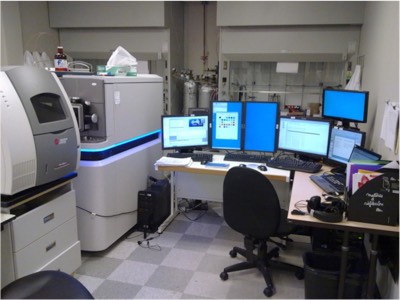
3. Waters SYNAPT G2 HDMS coupled with Beckman PA800plus Capillary Electrophoresis is a hyphenated system that integrates capillary electrophoresis separation with ion mobility separation and time-of-flight mass analysis, resulting in a mass spectrometer that can differentiate analytes by size, shape, charge, as well as mass. The system brings together advantages of capillary electrophoresis (separation of multiple analytes in close to physiological conditions, measuring rate and equilibrium constants in solution not in a gas phase, simultaneous UV detection, ESI coupling with MS) and mass spectrometry (multiplex detection of 1000s ions, m/z identification, structure elucidation, stoichiometry of binding, label-free detection, ion size comparison).
We are using the above mass spectrometers for multiple projects about proteomics and metabolomics of extracellular vesicles.
Capillary Electrophoresis:
Beckman Coulter PA800plus with an MS detector
Beckman Coulter ProteomeLab PA800 with UV, LIF, and PDA detectors
Beckman Coulter P/ACE MDQ with UV, LIF, and PDA detectors
Lumex CAPEL-205 with a UV detector
Capillary electrophoresis (CE) is a versatile technique that offers fast separations of biomolecules with exceptional efficiency and resolution. We currently have four CE systems in the lab. The PA800plus is coupled with the Waters SYNAPT G2 mass spectrometer. The PA800 and P/ACE MDQ are used for DNA aptamer selection. The CAPEL-205 with UV detection features an extended autosampler capacity of up to 59 positions and analyses small molecule metabolites like cannabinoids and amino acids.
Amersham Biosciences AKTA Prime FPLC System
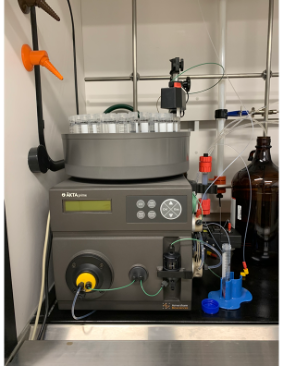
Fast protein liquid chromatography (FPLC) is a purification technique used to separate protein mixtures and collect the separated components of interest. The AKTA Prime system has automatic UV detection and temperature compensation. We use the FPLC system to produce recombinant proteins for our aptamer-based diagnostics.
FortéBio (Sartorius) BLItz
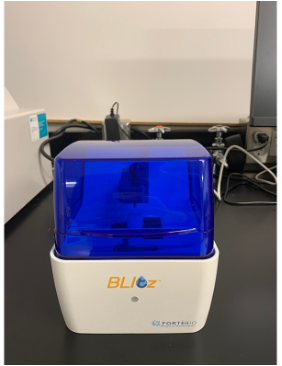
Biolayer Interferometry (BLI) is an optical technique that measures macromolecular interactions by analyzing interference patterns of white light reflected from the surface of a biosensor tip. In the BLI experiment, the protein is immobilized to a Dip and Read biosensor, and the binding of the aptamer is then measured. A change in the number of molecules bound to the end of the biosensor tip causes a shift in the interference pattern. The response is measured as a shift in the interference pattern proportional to the number of molecules bound to the biosensor's surface. The response is recorded and displayed on a sensorgram in real-time. It allows us to calculate kinetic constants (kon, koff) and an equilibrium constant (Kd) of DNA aptamers to protein targets.
Alpha Innotech FluorChem Q System
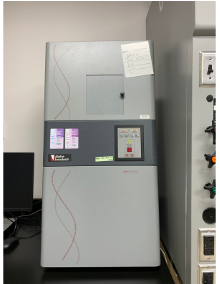
The imaging system is used for a wide array of quantitative imaging applications ranging from chemiluminescence imaging, fluorescence imaging, gel, film, and membrane imaging to culture and microplate-based assays. It has a CCD camera with a 1.92-megapixel resolution and a 12-bit dynamic range ideal for chemiluminescence, fluorescence, and absorbance imaging. The software can perform a comprehensive analysis like molecular weight calculation, Rf determination, 1D lane densitometry, 2D spot, gel scoring, and automated colony counting.
FilterMax F5 multi-mode microplate reader with Fluorescence Polarization
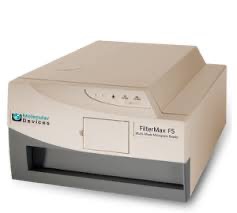
The microplate reader from Molecular Devices provides UV and visible absorbance, top, and bottom fluorescence intensity, glow luminescence, Fluorescent Polarization (FP), and Time-Resolved Fluorescence modes in 96- to 384-well plates with wavelength selection options from 230-750 nm. It is used for typical absorbance applications and assays, including ELISAs, nucleic acid and protein quantitation, and microbial growth. FP is a widely used technique to assess biomolecular interactions, including protein-aptamer binding and DNA hybridization, as well as enzyme activity.
Qubit 4 Fluorometer
The Invitrogen Qubit 4 Fluorometer is the next generation of the popular benchtop fluorometer designed to measure DNA, RNA, and protein accurately. The new Qubit 4 also quickly measures RNA integrity and quality. The easy-to-use touch screen menus make it easy to select and run the assays you need, with results displayed in just a few seconds.
Light sources: Blue LED (max ~470 nm), Red LED (max ~635 nm)
Excitation filters: Blue 430–495 nm, Red 600–645 nm
Emission filters: Green 510–580 nm, Red 665–720 nm
NanoDrop One Microvolume UV-Vis Spectrophotometer
The spectrophotometer capabilities:
Wide spectral range (190-850 nm) for measuring a variety of samples types: Peptides (205 nm), DNA and RNA (260 nm), Purified protein (280 nm), Toxicology assays and industrial dyes (490 nm), Gold nanoparticles (520 nm), Colorimetric protein assays (BCA 562 nm, Bradford 595 nm, Modified Lowry 650 nm, Pierce 660 660 nm), Optical Density measurements (600 nm). Pedestal measurements require only 0.5 - 2µL of your sample and do not require sample dilution, even for highly concentrated samples. There are several pre-configured methods for DNA, Protein A280, Microarray, Protein and Labels, Pierce 660, Bradford, BCA, and Lowry.
Microchip-based real-time PCR analyzer AriaDNA

Microchip-based real-time PCR analyzer from Lumex Instruments is used for rapid qualitative and quantitative analysis of nucleic acids in various biological samples for a variety of applications, including the diagnosis of hereditary diseases; the identification of genetic fingerprints (used in forensic sciences and paternity testing); and the detection and diagnosis of infectious diseases.
Thermal cyclers – Eppendorf and Ampicell
The Thermal Cyclers (also known as a Thermocycler, PCR Machine, or DNA Amplifier) is a laboratory apparatus used to amplify segments of DNA via PCR. The device has a thermal block with holes where tubes holding the PCR reaction mixtures can be inserted. The cycler then raises and lowers the block's temperature in discrete, pre-programmed steps for the designated number of cycles.
Western Blotting
The iBlot 2 Gel Transfer Device is a dry transfer device that performs western blotting transfer efficiently and reliably, within seven minutes, without liquid buffers. The iBlot 2 system is compatible with both polyvinylidene difluoride (PVDF) and nitrocellulose membranes and has comparable performance to traditional wet-transfer methods in a fraction of the time.
The iBind Western Device is an automated western-processing device that performs every step from blocking to washes to antibody incubations via sequential lateral flow (SLF). SLF allows the timely release and flow of solutions and antibodies to the membrane without needing an external power source, shakers, or trays. Each solution is released from the iBind device wells to an iBind Card via SLF in ~2.5 hours. The glass fiber matrix of the card allows for a homogenous and consistent flow of the solutions over the membrane, increasing the antigen-antibody interaction.